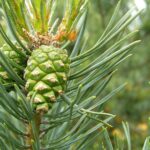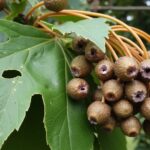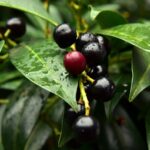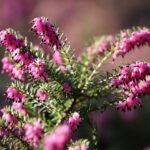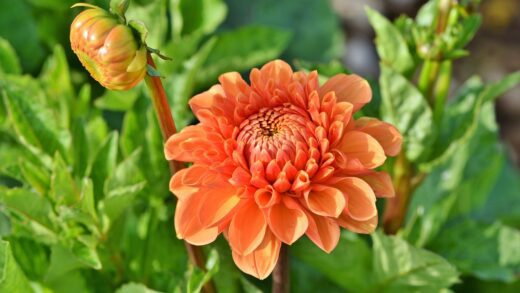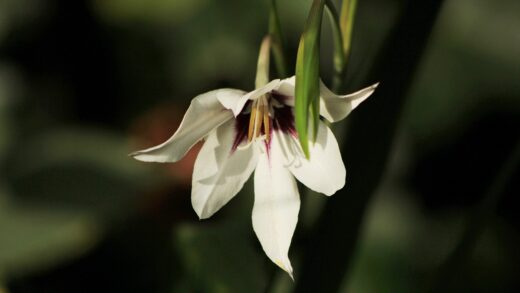The Scots pine is a supremely cold-hardy species, a characteristic forged by its evolution across the vast, frigid landscapes of northern Eurasia. In a garden or landscape setting, a healthy, well-established Scots pine requires very little special attention to successfully overwinter, as it is genetically programmed to withstand freezing temperatures, snow, and ice. However, the challenges of winter for a cultivated pine can sometimes differ from those in its natural forest habitat. Issues such as winter burn, damage from heavy snow loads, and the vulnerability of young, newly planted trees mean that a basic understanding of winter care principles is beneficial. By taking a few preventative steps, especially for younger specimens, you can ensure your pine emerges from dormancy in the spring healthy, unharmed, and ready for a new season of growth.
The natural hardiness of the Scots pine is rooted in its ability to undergo a process of cold acclimation in the autumn. As days shorten and temperatures drop, the tree undergoes a series of physiological changes at the cellular level. It reduces the amount of water within its cells and increases the concentration of sugars and other solutes, which act as a natural antifreeze, preventing the formation of damaging ice crystals within the living tissues. This process allows the needles and woody parts of the tree to survive temperatures far below freezing without injury. A healthy, established tree will perform this process automatically and efficiently.
Despite this impressive hardiness, even mature pines can be susceptible to a condition known as winter burn or desiccation. This occurs when the needles lose more water through transpiration on sunny, windy winter days than the frozen roots can absorb from the ground to replace it. The result is a browning or “burning” of the needles, typically on the side of the tree exposed to the prevailing winter winds and afternoon sun. While usually not fatal, it can be disfiguring and can weaken the tree if it occurs year after year.
Young and recently planted Scots pines are the most vulnerable to winter’s challenges. Their root systems are not yet fully developed and widespread, making them less efficient at water uptake and more susceptible to both desiccation and frost heaving in the soil. Their thin bark and smaller stature also make them more prone to damage from browsing animals and heavy snow accumulation. Therefore, winter care for Scots pines is primarily focused on providing extra protection for these younger trees to help them through their first few winters until they are large enough and well-established enough to fend for themselves.
Natural cold hardiness
The innate ability of the Scots pine to withstand extreme cold is one of its most defining characteristics. This species can comfortably survive winter temperatures dropping to -45°C (-50°F) or even lower, placing it in the hardiest of climate zones. This resilience is not a passive trait but an active, adaptive process. The tree’s metabolism slows dramatically as it enters dormancy, conserving energy for the long winter months. The evergreen nature of its needles allows it to photosynthesize on milder, sunny winter days, providing a small but important energy source when deciduous trees are completely dormant.
The physical structure of the tree also contributes to its winter survival. The thick, fissured bark on the lower trunk of mature trees provides excellent insulation for the vital cambium layer beneath. The branches of many Scots pine varieties are strong and flexible, allowing them to shed snow more effectively than species with more rigid branching habits. Furthermore, the waxy cuticle on the needles not only helps to prevent water loss during summer droughts but also provides a physical barrier against the drying winds of winter, reducing the risk of desiccation.
This natural hardiness means that for mature, healthy Scots pines planted in an appropriate site, no special winter protection is generally required. The tree’s own genetic and physiological adaptations are more than sufficient to see it through the winter in regions well within its hardiness zone. In fact, attempting to “protect” a mature tree by wrapping it in burlap can sometimes do more harm than good by trapping moisture, reducing air circulation, and creating a haven for pests. It is far more important to focus on maintaining the tree’s health throughout the growing season, as a vigorous tree will enter winter in the best possible condition.
It is also important to select a Scots pine that is from a genetic source, or provenance, that is well-suited to your local climate. The Scots pine’s vast natural range means that there is significant genetic variation within the species. Trees grown from seed collected in a milder climate may not be as fully cold hardy as those originating from a more northerly or high-altitude location. Whenever possible, choosing a tree that has been locally grown or is known to be from a hardy seed source will provide the greatest assurance of its ability to thrive in your region’s winter conditions.
Preparing young trees for winter
Young and recently transplanted Scots pines lack the extensive root systems and thick, insulating bark of their mature counterparts, making them more susceptible to winter injury. Preparation for their first few winters should begin in the late summer and autumn. It is crucial to cease all fertilization by mid-summer to avoid stimulating new growth that will not have time to harden off before the first frost. You should also ensure the tree is well-watered throughout the autumn, right up until the ground freezes. A tree that enters winter with adequate moisture in its tissues and the surrounding soil is much less likely to suffer from winter desiccation.
Applying a layer of organic mulch around the base of the young tree in the autumn is one of the most beneficial steps you can take. A 5 to 10 centimeter layer of wood chips, pine straw, or shredded bark helps to insulate the soil. This moderation of soil temperature protects the shallow roots from extreme cold and reduces the likelihood of frost heaving, a phenomenon where the soil repeatedly freezes and thaws, which can lift the root ball and damage the roots. The mulch should be pulled back a few centimeters from the trunk to prevent moisture buildup and potential rot.
For very young trees planted in exposed, windy locations, constructing a physical windbreak can be helpful in preventing winter burn. This can be as simple as driving a few stakes into the ground on the windward side of the tree (usually the north or west) and stretching a piece of burlap between them. It is important that the burlap does not touch the needles, as this can trap moisture and cause its own problems. The goal is simply to filter the wind and reduce its drying effect on the foliage. This protection is typically only needed for the first one or two winters.
Protection from animal damage is also a key consideration for young pines. The bark and tender shoots can be an attractive food source for rabbits and deer during the winter when other food is scarce. Placing a plastic tree guard or a cylinder of hardware cloth around the trunk can effectively prevent damage from gnawing rabbits. For deer, a taller barrier or fence may be necessary until the tree’s main branches are above the browse line, which is typically around 1.5 to 2 meters off the ground.
Protecting against winter burn and desiccation
Winter burn is a common physiological issue that occurs when the needles of an evergreen lose water to the winter sun and wind at a faster rate than the frozen roots can absorb it from the soil. The resulting damage appears as brown, dry, and brittle needles, usually most prominent on the south or southwest side of the tree and on the side facing the prevailing winds. While it can look alarming, winter burn on a Scots pine is often cosmetic and the tree will typically recover, though the damaged needles will eventually fall off.
The most important preventative measure against winter burn is to ensure the tree is thoroughly hydrated before the ground freezes in the late autumn. A well-watered tree has more moisture reserves in its tissues to draw upon during the winter months. This is especially critical for young trees and for any pine, regardless of age, that is situated on a sandy, fast-draining site or in a particularly exposed location. A final, deep soaking in the last few weeks before the ground freezes can make a significant difference.
For particularly vulnerable or valuable specimen trees, an anti-desiccant or anti-transpirant spray can provide an additional layer of protection. These products are sprayed directly onto the foliage in the late autumn after temperatures have dropped but before they are consistently below freezing. They work by coating the needles with a thin, waxy, or polymer film that helps to seal in moisture and reduce the rate of water loss from transpiration. The protective coating gradually weathers away over the winter. It is crucial to follow the product’s application instructions carefully for it to be effective.
Site selection remains the ultimate long-term defense against chronic winter burn. When planting a new Scots pine, try to choose a location that offers some protection from the harshest winter winds and the most intense afternoon sun. Planting on the east or north side of a building or in a location where other trees can provide a windbreak can significantly reduce the environmental stress the tree experiences during the winter. For existing trees that suffer from winter burn annually, considering the strategic planting of other hardy shrubs or trees to create a future windbreak could be a viable long-term solution.
Managing snow and ice damage
The Scots pine generally has a growth habit that allows it to handle snow reasonably well. Its branches are typically strong and somewhat flexible, and its open canopy structure can prevent the accumulation of excessively heavy loads. However, particularly heavy, wet snow or significant ice storms can still pose a risk of branch breakage, especially on trees with broad, spreading forms or those with weak branch attachments. Proactive management and careful removal can help to mitigate this risk.
During a heavy snowfall, if you are concerned about the weight accumulating on the branches, you can gently remove some of the snow. It is very important to do this carefully. Use a soft broom or a pole and push upwards from underneath the branches to lift them and allow the snow to fall off. Never pull the branches down or shake the trunk, as this can cause the already stressed branches to snap. This intervention is most effective and necessary with wet, heavy snow; light, fluffy powder is much less of a concern.
Ice accumulation from freezing rain is a more serious and dangerous situation. Ice can add a tremendous amount of weight to the branches, encasing them in a rigid layer that makes them brittle. In this situation, it is generally best to do nothing and let the ice melt naturally. Attempting to knock the ice off the branches is very likely to cause them to break. The best course of action is to stay away from the tree, as falling, ice-laden branches can be extremely dangerous.
The best long-term strategy for preventing snow and ice damage is proper structural pruning when the tree is young. By establishing a single, strong central leader and removing any branches with narrow, V-shaped crotches or weak attachments, you can build a much stronger tree framework that is better able to withstand winter loads. A well-pruned tree will have well-spaced, strongly attached branches that are less likely to fail under stress. This proactive approach to building a strong structure is far more effective than any reactive measures taken during a storm.
📷 Arnstein Rønning, CC BY 3.0, via Wikimedia Commons


